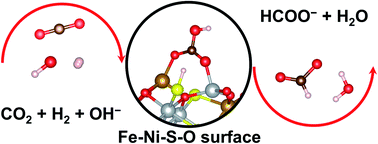Abstract
Increasing carbon dioxide (CO2) emissions, resulting in climate change, have driven the motivation to achieve the effective and sustainable conversion of CO2 into useful chemicals and fuels. Taking inspiration from biological processes, synthetic iron–nickel-sulfides have been proposed as suitable catalysts for the hydrogenation of CO2. In order to experimentally validate this hypothesis, here we report violarite (Fe,Ni)3S4 as a cheap and economically viable catalyst for the hydrogenation of CO2 into formate under mild, alkaline conditions at 125 °C and 20 bar (CO2 : H2 = 1 : 1). Calcination of violarite at 200 °C resulted in excellent catalytic activity, far superior to that of Fe-only and Ni-only sulfides. We further report first principles simulations of the CO2 conversion on the partially oxidised (001) and (111) surfaces of stoichiometric violarite (FeNi2S4) and polydymite (Ni3S4) to rationalise the experimentally observed trends. We have obtained the thermodynamic and kinetic profiles for the reaction of carbon dioxide (CO2) and water (H2O) on the catalyst surfaces via substitution and dissociation mechanisms. We report that the partially oxidised (111) surface of FeNi2S4 is the best catalyst in the series and that the dissociation mechanism is the most favourable. Our study reveals that the partial oxidation of the FeNi2S4 surface, as well as the synergy of the Fe and Ni ions, are important in the catalytic activity of the material for the effective hydrogenation of CO2 to formate.

- This article is part of the themed collection: Carbon dioxide utilisation


 Please wait while we load your content...
Please wait while we load your content...